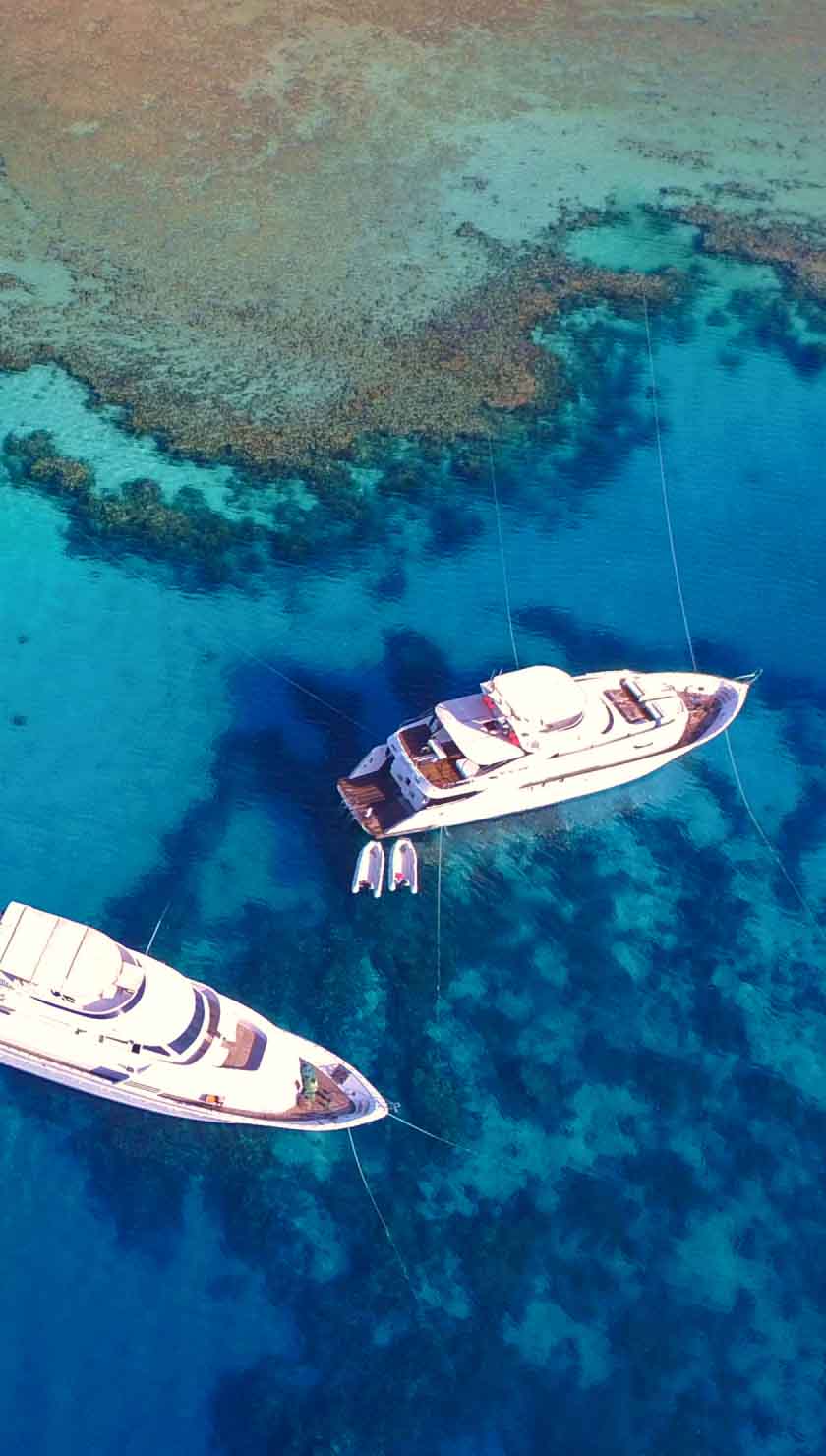Liveaboard diving in the Similan Islands is the peak of Thailand dive experiences. Its huge granite boulders with caverns and arches offer shark diving, schools of fish, huge sea fans, and general world-class quality of habitats and species. Elephant Head Rock, West of Six, and Christmas Point are only a few of the 20 plus dive sites. Similan scuba diving varies in difficulty, but currents in certain areas makes them better-suited for experienced divers. Lush greenery and white sand beaches ring the nine islands, completing the view from above water. Liveaboard boats diving at Richelieu Rock will bring you to the pelagics capital of Thailand. Around this limestone pinnacle jutting from the depths of the ocean, upwellings rich with plankton invite whale sharks, mantas and barracudas, not to mention the macro-life hiding amongst Richelieu's famous purple soft corals and sea fans. The strong currents here call for experienced divers. Koh Tachai and Koh Bon, members of the Similan Island National Park, are often visited en route to Richelieu and offer more pelagics, Napoleon Wrasse, and even night diving for macro-critters.
A Liveaboard dive tour in the Andaman Islands includes the crown jewels of Thailand diving (Similans and Richelieu), but they don't stop there. One additional highlight of these trips is the lush Surin Islands, where non-divers and divers alike are bewitched by the small cove beaches, island wildlife, and accessible snorkelling sites- not to mention the highest hard coral diversity in Thailand. Another incredible North Andaman dive area is the Mergui Archipelago of Burma, which opened to divers in the late 1990s; its undisturbed ecosystem offers the whole range from huge pelagics down to tiny macro-critters. Experienced divers will be best suited to week-long North Andaman itineraries, which visit some remote destinations with currents and open water. North Andaman liveaboards run from October through May for best visibility and surface conditions. The water temperature averages a comfortable 27-30°C. Usually, North Andaman liveaboard itineraries include the Similan Island, Richelieu Rock, the Surin Islands, and sometimes south Burma, depending on the itinerary length. Liveaboard diving in the South Andaman Sea presents a wealth of offerings just off the front door of Phuket. Leading the way are Hin Daeng and Hin Muang, underwater pinnacles covered with carpets of anemones, sponges, and sea fans, which host regular whale sharks and manta rays. Experienced divers are best suited to the currents swirling around these pinnacles. South Andaman liveaboards also visit Koh Ha and Koh Rok; these uninhabited, white-sand islands offer one of the best-preserved coral reefs in the country. Entry-level divers can find their niche in the South Andaman, where dive certification courses are offered on Phuket and Koh Phi Phi. The length of liveaboard itineraries in the South Andaman Sea ranges from two to six nights, giving entry-level divers a chance to experience a liveaboard along with more seasoned enthusiasts. The budget ranges from about 150 to over 400 euros per night, and the boats are M/V or S/V diving yachts. Trips usually run from April through October, departing from Chalong pier in Phuket or Pak Bara pier near the town of Hat Yai.
More about diving in Thailand
- Thailand offers a variety of dive sites from fringing reefs, deep drop-offs, wrecks, walls, caverns, tunnels, pinnacles and open ocean adventures.
- Submerge at Koh Phi Phi's coral gardens and limestone slopes, hosting everything from seahorses to sharks.
- Wreck dive in Khao Lak on your way out to the North Andaman Sea.
- Dive the untouched Mergui Archipelago in Burma, newly open to diving and rich with life.
- Koh Tachai hosts pelagics just like Richelieu- dive here for mantas, whale sharks, tuna, and fun underwater topography.
- Koh Bon is a premier manta site, but it also adds reef sharks and macro to the mix.
- Lose yourself in the profusion of marine life on and around Hin Daeng and Hin Muang's vertical cliffs.
- Maximize your dives per day by living onboard and have dive sites on your doorstep daily.
Ports of departure and how to get there
North Andaman liveaboard trips usually depart from Khao Lak or Phuket. Getting to Phuket is easy with a 1 hour flight from Bangkok or direct international flights from Kuala Lumpur, Hong Kong, Singapore, and other Southeast Asian destinations. Phuket is also reachable by train, bus, and car within Thailand. Hat Yai can be reached by domestic or select international flights (from Kuala Lumpur). Trains and buses run to Hat Yai from within Thailand, and even from Malaysia. Khao Lak can also be reached from Bangkok by overnight buses headed toward Phuket, but make sure they're taking a route that allows you to disembark in Khao Lak.
Getting to Khao Lak is easy by car or bus from Phuket, about 70 kilometres to the south. The travel time is roughly one hour. Khao Lak has no airport. For entry-level divers, Khao Lak's proximity to the Similan Islands makes it a great place to combine a PADI Open Water course with amazing day trips to Thailand's premier Andaman dive destination.
Divers with extra time in Phuket can visit the pristine coral garden of Shark Point or the Kingcruiser Wreck, not to mention taking advantage of nightlife, food, and land tour options. If you're planning a dive certification trip, Phuket or its neighbours (Koh Phi Phi, Koh Lanta), are the perfect locations for your PADI Open Water course
Best Time to Travel
The best time to dive in Thailand is year-round. However, the peak Thailand diving season for the Gulf of Thailand is from May through September and from October through April for the Andaman Sea. The water temperature in Thailand ranges from 28 degrees Celsius (82 Fahrenheit) to 30 degrees Celsius (86 Fahrenheit). Visibility in Thailand's waters is optimum throughout the area with an average of 30 meters (100 feet). Diving depths will typically vary depending on the dive site, but usually, do not exceed 36 meters (120 feet). Currents are usually mild and the overall air temperature is hot with high humidity.
Liveaboard diving in Thailand offers some of the healthiest reefs and largest schools of fish than at any other region. With the Thailand coast on both the Andaman Sea and the Gulf of Thailand, you can see often see whale sharks, hammerheads, manta rays, barracuda and much more.











